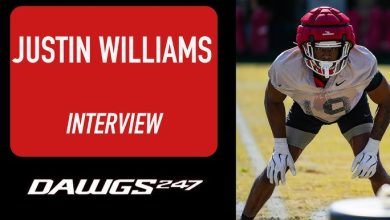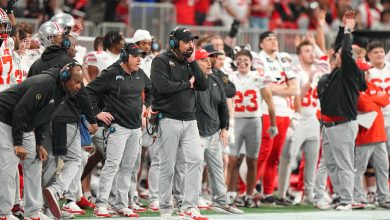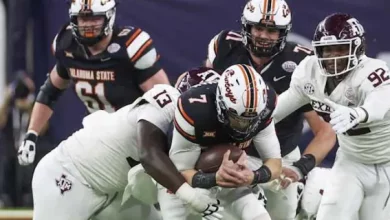Cole Cubelic praises Georgia Bulldogs for having the best tight end room in the SEC, highlighting their depth, talent, and versatility at the position.

In the ever-evolving landscape of college football, certain positions garner more attention for their impact on a team’s success. Among these, the tight end position has gained prominence as a versatile, dynamic role that can influence both the passing and running game. When Cole Cubelic, a respected college football analyst and former Auburn offensive lineman, proclaims the Georgia Bulldogs possess the “best tight end room in the SEC,” it warrants a deeper look into what makes this unit stand out.
Georgia’s tight end corps has become a defining feature of their offensive identity, contributing significantly to their sustained success under coach Kirby Smart. This recognition not only underscores Georgia’s talent and depth but also highlights the strategic importance of tight ends in modern SEC football.
This article will explore the factors that contribute to Georgia’s tight end room’s elite status, profile key players, analyze how they fit into Georgia’s offensive philosophy, and consider the broader implications for the SEC and college football.
The Evolution of the Tight End Role in College Football
Traditionally, tight ends were primarily blockers and short-yardage targets. Over the past decade, however, the role has transformed into a hybrid position requiring pass-catching prowess, route-running ability, and versatile blocking skills. Teams with dynamic tight ends can create mismatches, add unpredictability to their offense, and elevate their overall attacking threat.
In the SEC, known for its physicality and defensive prowess, having a tight end who can threaten defenses in multiple ways provides a strategic edge. Georgia, under Kirby Smart, has exemplified this evolution, integrating tight ends as key contributors in both the passing game and in-line blocking schemes.
Georgia’s Tight End Room: An Overview
Depth and Talent
Georgia’s tight end room is arguably the most talented and versatile in the SEC, featuring a mix of experienced veterans and emerging young players. The unit combines proven production, high-end athleticism, and the potential for growth, making it a nightmare for defenses to scheme against.
Strategic Importance
Georgia’s offensive philosophy emphasizes a balanced attack—effective run game complemented by explosive passing options. Tight ends play a central role in both aspects, serving as blockers in the run game and reliable targets in the passing game, especially in the intermediate and red zone routes.
Key Players in Georgia’s Tight End Room
While Georgia’s roster can evolve over time, as of the 2023 season, several players stand out for their contributions and potential:
1. Brock Bowers: The Star Tight End
Brock Bowers is arguably the most dominant tight end in college football. His combination of size, speed, hands, and football IQ makes him a matchup nightmare. Standing around 6’4” and 230 pounds, Bowers has been a focal point of Georgia’s offense since his arrival.
His ability to line up in multiple positions—inline, slot, or split out—allows Georgia to create mismatches. Bowers excels in the red zone, where his athleticism and route-running make him a consistent scoring threat. His blocking is also solid, adding to his value as a complete tight end.
Bowers’ versatility means defenses must allocate extra attention, often leaving other options open. His production and impact have elevated Georgia’s offensive ceiling significantly.
2. Ladd McConkey: The Dynamic Playmaker
While primarily a wide receiver, Ladd McConkey has also been utilized as a hybrid tight end in certain packages, thanks to his size (around 6’0”, 190 pounds) and agility. His role emphasizes quick releases, crossing routes, and red-zone mismatches.
3. Arik Gilbert: The Athletic Prospect
Arik Gilbert, a former five-star recruit, transferred to Georgia and offers a unique mismatch potential due to his size (around 6’5”, 250 pounds) and athleticism. His development is closely watched, as he could become a key weapon if fully integrated into the offense.
4. Other Emerging Talents
Georgia also has a cadre of younger players and depth options, including walk-ons and developmental prospects, who could rise to prominence as the season progresses.
Why Cole Cubelic Praises Georgia’s Tight End Room
Cole Cubelic’s endorsement of Georgia’s tight end unit stems from several factors:
1. Talent and Production
Georgia’s tight ends, led by Brock Bowers, have demonstrated elite production. Bowers, in particular, has been a game-changer, earning All-American honors and attracting NFL scouts’ attention. The depth of talent and the emergence of other contributors showcase Georgia’s commitment to the position.
2. Versatility and Scheme Fit
Georgia’s offensive scheme leverages tight ends as multi-dimensional threats. The ability of players like Bowers to line up anywhere on the field, combined with their route-running and blocking skills, creates mismatches that defenses cannot easily neutralize.
3. Depth and Future Potential
Having multiple quality options allows Georgia to run complex schemes and keep players fresh. The presence of young, talented players indicates sustained strength at the position for years to come.
4. Impact on the Overall Offense
A formidable tight end room elevates Georgia’s offensive efficiency, affecting everything from play-action passing to red zone scoring. It allows for more creative schemes and makes Georgia’s offense less predictable.
The Strategic Impact of Georgia’s Tight End Room
Georgia’s tight ends serve as a critical component in several offensive concepts:
1. Play-Action Passing
With a strong run game and capable blockers, Georgia effectively uses play-action to freeze defenses, allowing tight ends like Brock Bowers to find soft spots in coverage for big gains.
2. Red Zone Efficiency
Tight ends are often prime targets in the red zone due to their size and catching ability. Georgia’s success in this area stems partly from the proficiency of their tight ends in contested-catch situations.
3. Mismatch Creation
Lineup versatility allows Georgia to create mismatches against linebackers or safeties, opening up intermediate routes and deep shots.
4. Blocking and Run Game
Tight ends contribute significantly to Georgia’s physical run scheme, sealing edges and helping establish the ground attack that is fundamental to their success.
Broader Implications in the SEC and College Football
SEC’s Emphasis on Physicality and Versatility
The SEC is renowned for its tough, physical defenses. Offenses that can match that intensity with versatile tight ends are at a distinct advantage. Georgia’s tight end room exemplifies this principle, providing a blueprint for other programs aiming to elevate their offensive schemes.
Recruiting and Development
Georgia’s success at tight end is also a product of strong recruiting and player development. The ability to attract top-tier talent and develop them into multi-dimensional threats is crucial in the highly competitive SEC environment.
Evolution of Offensive Strategies
Cubelic’s praise underscores a broader trend: the tight end position is increasingly central to modern offensive schemes, especially in power conferences like the SEC. Teams that excel in this role can diversify their attack and exploit defenses more effectively.
Future Outlook: Georgia’s Tight End Room and Beyond
Georgia’s tight end room is expected to remain a strength in the coming seasons. Brock Bowers’ continued development, combined with emerging talents like Arik Gilbert or other freshmen, will sustain Georgia’s offensive dynamism.
Coach Kirby Smart’s emphasis on physicality, versatility, and recruiting excellence will ensure that Georgia’s tight end corps remains elite, setting a standard for SEC programs striving to compete at the highest level.
Cole Cubelic’s recognition of Georgia’s tight end room as the best in the SEC is well-founded. Their combination of talent, versatility, scheme fit, and impact on both the running and passing game establishes Georgia as a blueprint for modern offensive success.
In a league where defenses are fierce and physicality reigns supreme, Georgia’s tight ends provide the offensive punch needed to stay ahead of the competition. Their depth and talent not only contribute to Georgia’s current success but also set the stage for sustained dominance in college football.
As the SEC continues to evolve, Georgia’s tight end room exemplifies how a well-rounded, versatile unit can be a game-changer, making them a formidable force and justifying Cole Cubelic’s high praise.









